DPDK-22.11.2 [四] Virtio_user as Exception Path
因為dpdk是把網路卡操作全部拿到使用者層,與原生系統驅動不再相容,所以被dpdk接管的網路卡從系統層面(ip a/ifconfig)無法看到,同樣資料也不再經過系統核心。
如果想把資料再傳送到系統,就要用到virtio user。這種把資料從dpdk再傳送到核心的步驟,就叫做exception path。
有關virtio user,又有一系列的相關知識,這裡系統的介紹一下。
hypervisor
hypervisor是一個軟體,用來建立執行虛擬機器器(virtual machines/VMs)。hypervisor又叫做虛擬機器器監視器(virtual machine monitor/VMM)。執行hypervisor的機器叫做宿主機(host machine),在執行在hypervisor上的虛擬機器器叫做訪客機(guest machine)。
hypervisor有兩種型別,一種是直接執行在硬體上(Type 1-native or bare-metal hypervisors),hypervisor相當於作業系統;另一種是hypervisor執行在作業系統上(Type 2-hosted hypervisors)。
常見的hypervisor
hypervisor只是一種解決思路,目的就是為了更大化利用硬體資源。比如有一臺計算機,沒有虛擬化之前,只能給一個使用者使用,然而這個使用者不可能24小時線上,空閒時間,系統資源就浪費了。有了虛擬化,就可以把計算機虛擬出多個作業系統,給多個使用者使用,更大化的利用系統資源。並且可以根據使用者的重要性(付費情況)控制硬體資源的使用佔比和優先順序。現在的雲就是虛擬化的進一步延伸。
VMware hypervisors
VMware hypervisors有兩類產品,一種是Type 1,直接執行在硬體上:
- ESXi hypervisor/VMware ESXi (Elastic Sky X Integrated)
- VSphere hypervisor
另一種是Type 2,執行在作業系統上:
- VMware Fusion
- Workstation
- VirtualBox
Hyper-V hypervisor
Hyper-V hypervisor是微軟的產品,用在Windows上,是Type 1型別的,直接執行在硬體上。
Citrix hypervisors
XenServer是Citrix Hypervisor比較有名的產品,是Type 1型別,並且XenServer衍生出了Xen open source project。
Open source hypervisors
主要有KVM和Xen
Hypervisor KVM
Linux直接把kernel-based virtual machine (KVM)加到了系統中,並且對QEMU進行了補充。
Red Hat hypervisor
Red Hat hypervisor是基於KVM hypervisor開發的,同樣可以在很多其他Linux版本執行,比如Ubuntu。
虛擬化型別
全虛擬化
由虛擬程式提供全部的虛擬化指令,比如我們用的virtualbox/vmware workstation等桌面虛擬機器器。好處就是與硬體完全隔離,遷移方便,壞處就是犧牲了效能。
硬體虛擬化
由於全虛擬化效能受到影響,所以又提出了硬體虛擬化,由硬體提供虛擬化方案,虛擬機器器直接存取硬體,雖然效能得到了提升,但是也產生了弊端:不方便遷移,必須依賴特定硬體,硬體提供的功能不完善,很多操作無法執行。
半虛擬化
為了解決上面的兩個問題,又提出了半虛擬化,就是消耗效能的操作交給硬體(比如特定的解碼器)或者作業系統,而其他的操作還是在虛擬機器器中完成。半虛擬化中使用最廣泛的標準就是VirtIO。
VirtIO相當於是半虛擬化(paravirtualized hypervisor)的抽象層,有前端和後端,定義了一系列介面用於中間通訊。後端相當於硬體或者作業系統層,具體實現可以不同,只要給定相應的介面操作即可;前端通過呼叫這些介面達到作業系統資源的目的。
這樣的話,前端就可以放到虛擬機器器中,當需要更高效能操作時,通過前端存取後端資源,後端獲得資料後傳送到前端。
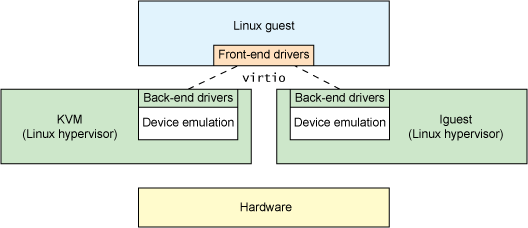
VirtIO Offload 就是通過VirtIO協定把操作解除安裝到硬體或者作業系統,也就是把一些消耗效能的操作從虛擬機器器中釋放出來,由硬體或者作業系統實現,最後把結果返回虛擬機器器(比如網路流量處理)。
Deep dive into Virtio-networking
基礎知識
網路
NIC (Network Interface Card) - 網路卡,就是專門用來offload(解除安裝)CPU工作的,把一些網路處理交由網路卡進行操作。
tun/tap - virtual point-to-point network devices that the userspace applications can use to exchange packets. The device is called a tap device when the data exchanged is layer 2 (ethernet frames), and a tun device if the data exchanged is layer 3 (IP packets).
When the tun kernel module is loaded it creates a special device /dev/net/tun. A process can create a tap device opening it and sending special ioctl commands to it. The new tap device has a name in the /dev filesystem and another process can open it, send and receive Ethernet frames.
IPC Inter-Process Communication
socket、eventfd和共用記憶體都是IPC的方式
實現方案
virtio-net/Networking with virtio: qemu implementation 基於QEMU的實現
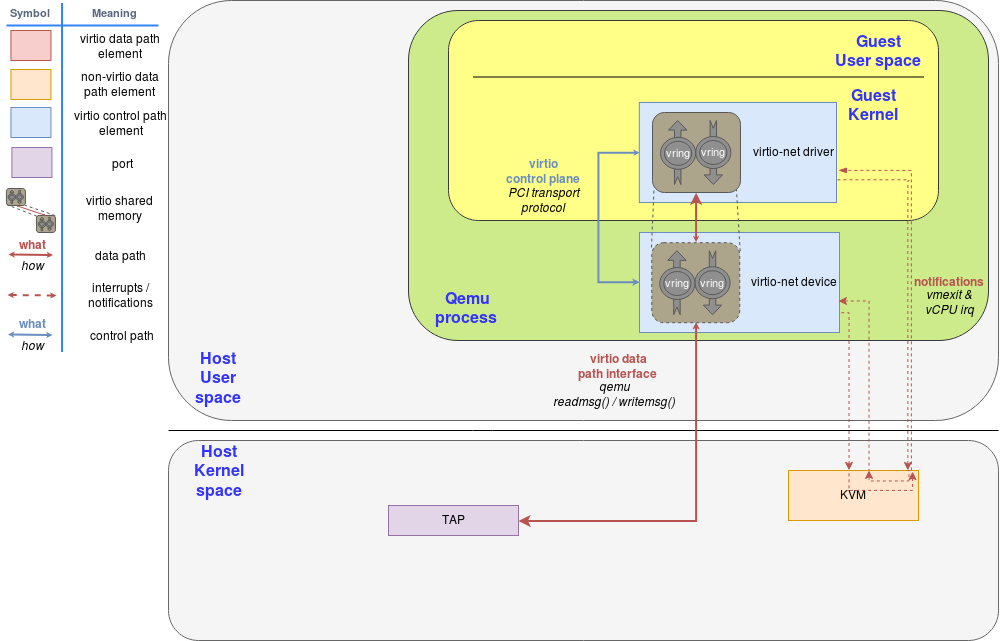
從圖上可以看到,qemu中處於guest kernel層的virtio net與qemu的virtio net通訊,qemu的virtio net最後與系統kernel層的tap通訊。中間經歷了多次user space和kernel space的切換,並且使用的是系統預設的驅動,還有大量的中斷處理,所以效能不高。
Vhost protocol
由於上面方案的侷限性,vhost提出了改進,就是把消耗效能的模組,offload到另一個模組執行。換句話說,虛擬機器器不適合做的工作,就交給其他模組做,通過一些通訊手段互動資料即可。
Vhost-net
Vhost-net就是對vhost協定的一種實現。這個功能已經整合到linux核心中。如果相關的核心模組載入後,可以在系統路徑下看到/dev/vhost-net目錄。
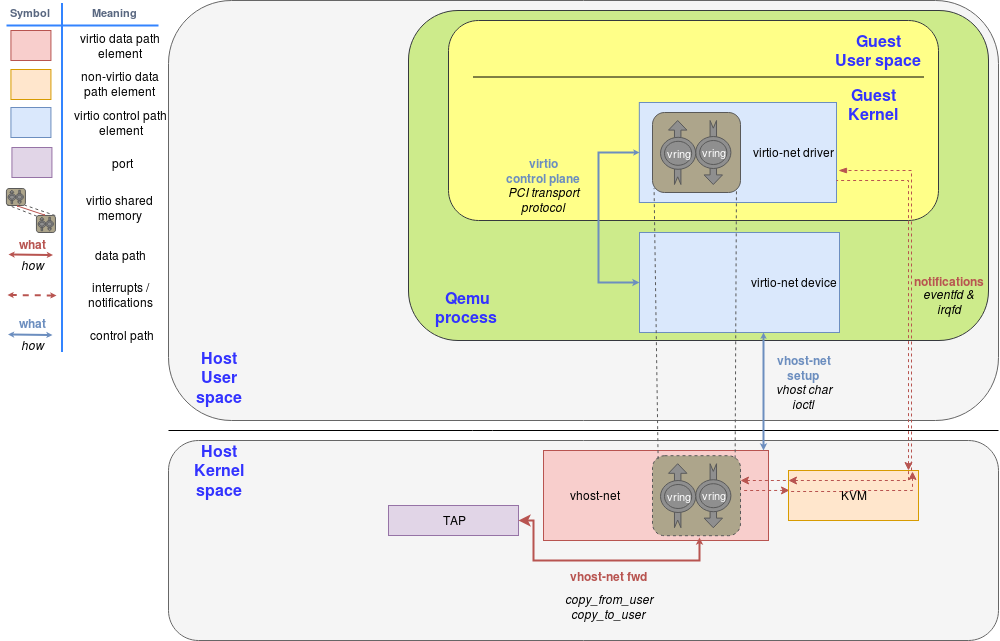
從這張圖上我們可以看到,原來通訊流程是qemu guest kernel中的virtio-net->qemu virtio-net->host kernel中的tap。現在中間少了一步,通過IPC(Inner-process communication)直接到host kernel的vhost-net,提高了效能。
vhost-user
上面的方案是通過共用記憶體的方式,對映到核心,但是還是有上下文切換。vhost-user把操作完全放到使用者層,使用socket的方式與核心通訊,沒有了上下文切換,也降低了開發難度。

上面這種圖可以看到,操作都被移動到使用者層,使用DPDK避免了上下文切換和中斷,大大提高了效能。
virtio-user
按照官方檔案所述,virtio-user是與vhost-user一起引入的。vhost-user作為後端,virtio-user作為前端。virtio-user除了可以用在容器,與vhost-user一起使用,還可以與vhost-kernel使用,把封包傳送回作業系統。
硬體加速
HW vDPA(Hardware vhost Data Path Acceleration)是SR-IOV VF Passthrough的一種實現。
最快的肯定是直接使用硬體作為後端,把操作直接交給硬體。但是基於硬體的侷限性比較大,功能也不如其他方式豐富,並且成本昂貴,所以除非在對效能要求非常高的場合,一般不會直接使用專有硬體作為後端。
Exception Path的方案介紹
TAP/TUN方案
這個是最早的方案,通過系統的TAP/TUN進行通訊,呼叫的系統標準的api,缺點就是上下文切換和中斷影響了效能。
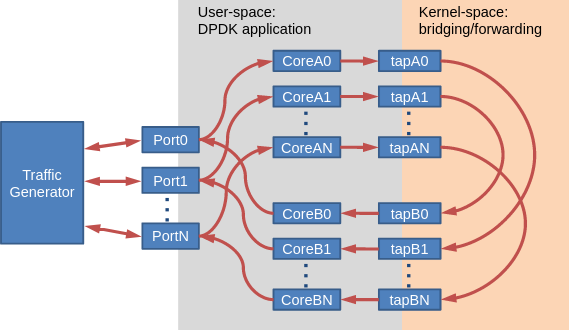
KNI Kernel NIC Interface
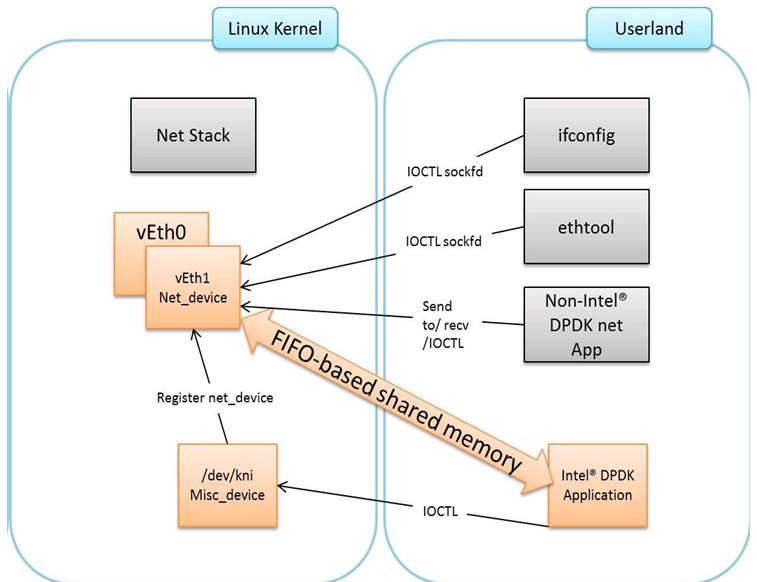
KNI比TAP/TUN的好處就是減少了資料拷貝,可以支援linux系統管理工具(ethtool等)。
但是缺點就是,已經過時了,不安全,功能不全。
virtio user
virtio user用來代替kni,其優點是:
- 被linux加入核心,不需要額外維護
- 功能更完善
- 效能更高
如下圖是virtio user的基本流程示意圖
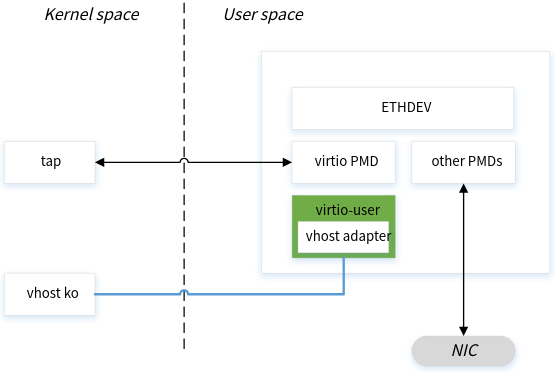
使用Testpmd測試virtio-user
build/app/dpdk-testpmd -l 12-15 -a 0000:84:00.0 \
--vdev=virtio_user0,path=/dev/vhost-net,queues=1,queue_size=1024 -- --numa
-l 12-15 表示使用cpu core12到15
-a 0000:84:00.0 表示使用指定的網口,該網口必須有流量進來。
--vdev=virtio_user0,path=/dev/vhost-net,queues=1,queue_size=1024 表示建立一個虛擬裝置,裝置名是virtio_user0,路徑是/dev/host-net(這樣就可以把資料傳送給系統了),queues=1表示通訊佇列有1個,queue_size=1024表示佇列大小是1024。
啟動後,通過ip a,可以看到多了一個tap0的裝置。上面指定的virtio_user0表示是使用的時候的名稱,至於系統顯示的名稱沒有指定,就會預設為tapx。
ip a
...
69: tap0: <BROADCAST,MULTICAST> mtu 1500 qdisc noop state DOWN group default qlen 1000
link/ether 1a:e0:f5:1f:21:5f brd ff:ff:ff:ff:ff:ff
裝置建立出來後是down狀態,需要up起來。官方範例指定了ip,實際上如果只是檢視是否有接收資料,可以不用指定ip。
ip link set dev tap0 up
在通過ifconfig檢視詳細資訊
ifconfig tap0
tap0: flags=4163<UP,BROADCAST,RUNNING,MULTICAST> mtu 1500
inet6 fe80::18e0:f5ff:fe1f:215f prefixlen 64 scopeid 0x20<link>
ether 1a:e0:f5:1f:21:5f txqueuelen 1000 (Ethernet)
RX packets 1175788 bytes 947947134 (904.0 MiB)
RX errors 0 dropped 1 overruns 0 frame 0
TX packets 6 bytes 516 (516.0 B)
TX errors 0 dropped 0 overruns 0 carrier 0 collisions 0
可以看到有資料傳遞進來。
如果有多個網口可以指定多個,這樣就會有兩個虛擬裝置tap0和tap1。
build/app/dpdk-testpmd -l 12-15 -a 0000:84:00.0,0000:84:00.1 \
--vdev=virtio_user0,path=/dev/vhost-net --vdev=virtio_user1,path=/dev/vhost-net -- --numa
另起一個程序,指定tap0為接收裝置,就可以接收到資料。
build/app/dpdk-testpmd -l 2-5 --vdev=net_af_packet0,iface=tap0 --in-memory --no-pci
使用basicfwd修改一個手動建立虛擬裝置的範例
#include <stdint.h>
#include <stdlib.h>
#include <inttypes.h>
#include <rte_eal.h>
#include <rte_ethdev.h>
#include <rte_cycles.h>
#include <rte_lcore.h>
#include <rte_mbuf.h>
#include <rte_config.h>
#include <rte_ethdev.h>
#include <unistd.h>
#define RX_RING_SIZE 1024
#define TX_RING_SIZE 1024
#define NUM_MBUFS 8191
#define MBUF_CACHE_SIZE 250
#define BURST_SIZE 32
uint16_t virport[64];
int virportnum = 0;
struct lcore_conf
{
unsigned n_rx_port;
unsigned rx_port_list[16];
int pkts;
} __rte_cache_aligned;
static struct lcore_conf lcore_conf_info[RTE_MAX_LCORE];
static inline int port_init(uint16_t port, struct rte_mempool *mbuf_pool)
{
uint16_t portid = port;
struct rte_eth_conf port_conf;
uint16_t nb_rxd = RX_RING_SIZE;
uint16_t nb_txd = TX_RING_SIZE;
int retval;
uint16_t q;
struct rte_eth_dev_info dev_info;
int istx=0;
if (!rte_eth_dev_is_valid_port(port))
return -1;
// 需要判斷是否是虛擬網路卡
// 因為動態建立的網路卡也會遍歷進來,需要額外處理
for (int i = 0; i < virportnum; i++)
{
if (port == virport[i])
{
istx=1;
break;
}
}
uint16_t rx_rings = 0, tx_rings = 0;
if (istx == 1)
{
tx_rings = 1;
}
else
{
rx_rings = 1;
}
memset(&port_conf, 0, sizeof(struct rte_eth_conf));
retval = rte_eth_dev_info_get(port, &dev_info);
if (retval != 0)
{
printf("Error during getting device (port %u) info: %s\n",
port, strerror(-retval));
return retval;
}
if (dev_info.tx_offload_capa & RTE_ETH_TX_OFFLOAD_MBUF_FAST_FREE)
port_conf.txmode.offloads |=
RTE_ETH_TX_OFFLOAD_MBUF_FAST_FREE;
retval = rte_eth_dev_configure(port, rx_rings, tx_rings, &port_conf);
if (retval != 0)
return retval;
retval = rte_eth_dev_adjust_nb_rx_tx_desc(port, &nb_rxd, &nb_txd);
if (retval != 0)
return retval;
// 建立的虛擬裝置與物理裝置沒有區別,都需要初始化
// 如果是物理裝置,就是接收資料;如果是虛擬裝置,就是傳送資料
if (istx == 0)
{
for (q = 0; q < rx_rings; q++)
{
retval = rte_eth_rx_queue_setup(port, q, nb_rxd, rte_eth_dev_socket_id(port), NULL, mbuf_pool);
if (retval < 0)
return retval;
retval = rte_eth_dev_set_ptypes(port, RTE_PTYPE_UNKNOWN, NULL, 0);
if (retval < 0)
{
printf("Port %u, Failed to disable Ptype parsing\n", port);
return retval;
}
}
}
else
{
for (q = 0; q < tx_rings; q++)
{
retval = rte_eth_tx_queue_setup(port, q, nb_txd, rte_eth_dev_socket_id(port), NULL);
if (retval < 0)
return retval;
}
}
retval = rte_eth_dev_start(port);
if (retval < 0)
return retval;
char portname[32];
char portargs[256];
struct rte_ether_addr addr;
retval = rte_eth_macaddr_get(port, &addr);
if (retval != 0)
return retval;
printf("Port %u MAC: %02" PRIx8 " %02" PRIx8 " %02" PRIx8 " %02" PRIx8 " %02" PRIx8 " %02" PRIx8 "\n", port, RTE_ETHER_ADDR_BYTES(&addr));
// 如果是物理裝置,就建立一個對應的虛擬裝置
if(istx==0)
{
snprintf(portname, sizeof(portname), "virtio_user%u", port);
// 修改一下mac,避免與物理裝置一致
addr.addr_bytes[5]=1;
// 建立虛擬裝置引數,指定路徑,裝置名稱,mac地址等
snprintf(portargs, sizeof(portargs), "path=/dev/vhost-net,queues=1,queue_size=%u,iface=%s,mac=" RTE_ETHER_ADDR_PRT_FMT, RX_RING_SIZE, portname, RTE_ETHER_ADDR_BYTES(&addr));
// 把裝置加入到系統
if (rte_eal_hotplug_add("vdev", portname, portargs) < 0)
rte_exit(EXIT_FAILURE, "Cannot create paired port for port %u\n", port);
uint16_t virportid = -1;
// 通過裝置名稱獲取裝置id
if (rte_eth_dev_get_port_by_name(portname, &virportid) != 0)
{
rte_eal_hotplug_remove("vdev", portname);
rte_exit(EXIT_FAILURE, "cannot find added vdev %s:%s:%d\n", portname, __func__, __LINE__);
}
// 記錄下虛擬裝置id
virport[virportnum] = virportid;
virportnum++;
}
// 虛擬裝置不可以開啟混雜模式
if(istx==0)
{
retval = rte_eth_promiscuous_enable(port);
if (retval != 0)
return retval;
for (int i = 0; i < RTE_MAX_LCORE; i++)
{
if (rte_lcore_is_enabled(i) == 0)
{
continue;
}
if (i == rte_get_main_lcore())
{
continue;
}
if (lcore_conf_info[i].n_rx_port > 0)
{
continue;
}
struct lcore_conf *qconf = &lcore_conf_info[i];
qconf->rx_port_list[qconf->n_rx_port] = port;
qconf->n_rx_port++;
break;
}
}
return 0;
}
static int lcore_main(void *param)
{
int ret;
int lcore_id = rte_lcore_id();
struct lcore_conf *qconf = &lcore_conf_info[lcore_id];
int master_coreid = rte_get_main_lcore();
uint16_t port;
if (qconf->n_rx_port == 0)
{
printf("lcore %u has nothing to do\n", lcore_id);
return 0;
}
if (lcore_id == rte_get_main_lcore())
{
printf("do not receive data in main core\n");
return 0;
}
RTE_ETH_FOREACH_DEV(port)
if (rte_eth_dev_socket_id(port) >= 0 &&
rte_eth_dev_socket_id(port) !=
(int) rte_socket_id())
printf("WARNING, port %u is on remote NUMA node to "
"polling thread.\n\tPerformance will "
"not be optimal.\n", port);
printf("\nCore %u forwarding packets. [Ctrl+C to quit]\n", rte_lcore_id());
uint16_t portid;
for (;;)
{
for (int i = 0; i < qconf->n_rx_port; i++)
{
int port = qconf->rx_port_list[i];
portid = port;
struct rte_mbuf *bufs[BURST_SIZE];
uint16_t nb_rx = rte_eth_rx_burst(port, 0, bufs, BURST_SIZE);
if (unlikely(nb_rx == 0))
continue;
uint16_t nb_tx = 0;
for (int i = 0; i < virportnum; i++)
{
// 找一個虛擬網路卡傳送出去
// 這裡只有一個裝置,可以這樣
// 如果有多個,需要設定好一一對應關係再傳送
nb_tx = rte_eth_tx_burst(virport[i], 0, bufs, nb_rx);
break;
}
for (int j = nb_tx; j < nb_rx; j++)
{
// 資料傳送完後,會自動釋放,沒有傳送的資料,需要手動釋放
rte_pktmbuf_free(bufs[j]);
}
}
}
return 0;
}
int main(int argc, char *argv[])
{
struct rte_mempool *mbuf_pool;
unsigned nb_ports;
uint16_t portid;
memset(lcore_conf_info, 0, sizeof(lcore_conf_info));
memset(virport, -1, sizeof(virport));
int ret = rte_eal_init(argc, argv);
if (ret < 0)
rte_exit(EXIT_FAILURE, "Error with EAL initialization\n");
nb_ports = rte_eth_dev_count_avail();
mbuf_pool = rte_pktmbuf_pool_create("MBUF_POOL", NUM_MBUFS * nb_ports, MBUF_CACHE_SIZE, 0, RTE_MBUF_DEFAULT_BUF_SIZE, rte_socket_id());
if (mbuf_pool == NULL)
rte_exit(EXIT_FAILURE, "Cannot create mbuf pool\n");
// 這裡遍歷需要注意,遍歷期間動態建立的虛擬裝置也會被遍歷到
RTE_ETH_FOREACH_DEV(portid)
if (port_init(portid, mbuf_pool) != 0)
rte_exit(EXIT_FAILURE, "Cannot init port %" PRIu16 "\n", portid);
rte_eal_mp_remote_launch(lcore_main, NULL, SKIP_MAIN);
int lcore_id;
RTE_LCORE_FOREACH_WORKER(lcore_id)
{
if (rte_eal_wait_lcore(lcore_id) < 0)
{
ret = -1;
break;
}
}
rte_eal_cleanup();
return 0;
}
編譯執行,通過ip a檢視
ip a
...
70: virtio_user0: <BROADCAST,MULTICAST> mtu 1500 qdisc noop state DOWN group default qlen 1000
link/ether 1a:e0:f5:1f:21:01 brd ff:ff:ff:ff:ff:ff
可以看到該裝置,因為指定了名稱,則不再是tap0,而是我們指定的virtio_user0。mac地址也是我們指定的。
開啟裝置,再次檢視資訊
ip link set dev virtio_user0 up
ip a
70: virtio_user0: <BROADCAST,MULTICAST,UP,LOWER_UP> mtu 1500 qdisc mq state UNKNOWN group default qlen 1000
link/ether 1a:e0:f5:1f:21:01 brd ff:ff:ff:ff:ff:ff
inet6 fe80::92e2:baff:fe85:3d01/64 scope link tentative
valid_lft forever preferred_lft forever
檢視網路卡接收封包資訊
ifconfig virtio_user0
virtio_user0: flags=4163<UP,BROADCAST,RUNNING,MULTICAST> mtu 1500
inet6 fe80::92e2:baff:fe85:3d01 prefixlen 64 scopeid 0x20<link>
ether 1a:e0:f5:1f:21:01 txqueuelen 1000 (Ethernet)
RX packets 2899366 bytes 2334954577 (2.1 GiB)
RX errors 0 dropped 1 overruns 0 frame 0
TX packets 0 bytes 0 (0.0 B)
TX errors 0 dropped 0 overruns 0 carrier 0 collisions 0
http://doc.dpdk.org/guides-22.11/howto/virtio_user_as_exception_path.html
https://www.redhat.com/en/topics/virtualization/what-is-a-hypervisor
https://en.wikipedia.org/wiki/Hypervisor
https://www.ibm.com/topics/hypervisors
https://aws.amazon.com/cn/what-is/hypervisor/
https://developer.ibm.com/articles/l-virtio/
https://docs.oasis-open.org/virtio/virtio/v1.2/virtio-v1.2.html
https://www.redhat.com/en/blog/deep-dive-virtio-networking-and-vhost-net
https://qemu-project.gitlab.io/qemu/interop/vhost-user.html
https://www.redhat.com/en/blog/journey-vhost-users-realm
https://mp.weixin.qq.com/s/q3qAaMBGyQ5E2_2Dd-IvdA
https://www.cnblogs.com/bakari/p/8971710.html
https://doc.dpdk.org/guides-18.08/sample_app_ug/exception_path.html
https://doc.dpdk.org/guides/prog_guide/kernel_nic_interface.html